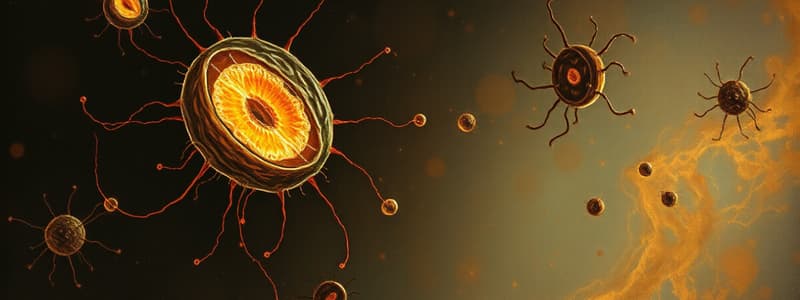Podcast
Questions and Answers
Stem cells can be classified by their potential. Which of the following classifications is NOT correct?
Stem cells can be classified by their potential. Which of the following classifications is NOT correct?
- Pluripotent
- Totipotent
- Bipotent (correct)
- Multipotent
What are three identifying characteristics of stem cells?
What are three identifying characteristics of stem cells?
- Ability to divide and grow (correct)
- Undifferentiated (correct)
- Ability to photosynthesize
- Specialized (correct)
What is the process in which cells become specialized in structure and function?
What is the process in which cells become specialized in structure and function?
Differentiation
One advantage of adult stem cells is that they are ___ to the donor.
One advantage of adult stem cells is that they are ___ to the donor.
What is one advantage of embryonic stem cells?
What is one advantage of embryonic stem cells?
What does totipotent mean?
What does totipotent mean?
What does pluripotent mean?
What does pluripotent mean?
What is the primary goal of stem cell research?
What is the primary goal of stem cell research?
What types of stem cell therapies are being used today?
What types of stem cell therapies are being used today?
How might therapeutic cloning aid stem cell therapies in the future?
How might therapeutic cloning aid stem cell therapies in the future?
What are some potential sources of embryonic stem cells for use in research and treatments?
What are some potential sources of embryonic stem cells for use in research and treatments?
What are stem cells?
What are stem cells?
Where are embryonic stem cells found?
Where are embryonic stem cells found?
Where are adult stem cells found?
Where are adult stem cells found?
What are induced pluripotent stem cells?
What are induced pluripotent stem cells?
What is somatic cell nuclear transfer?
What is somatic cell nuclear transfer?
What is a trophoblast?
What is a trophoblast?
What is a blastocyst?
What is a blastocyst?
Describe the embryonic stages from day 1 to 5.
Describe the embryonic stages from day 1 to 5.
What occurs in somatic cell nuclear transfer?
What occurs in somatic cell nuclear transfer?
What are the advantages of induced pluripotent stem cells?
What are the advantages of induced pluripotent stem cells?
Flashcards are hidden until you start studying
Study Notes
Stem Cells Overview
- Stem cells are categorized based on potential: totipotent, pluripotent, and multipotent.
- They originate from embryonic or adult sources, influencing their capabilities.
Characteristics of Stem Cells
- Undifferentiated: Stem cells have not yet developed into specialized cell types.
- Specialization: They can differentiate into specific cell types.
- Proliferation: Stem cells have the ability to divide and grow.
Differentiation Process
- Differentiation is when stem cells specialize in structure and function to perform specific roles.
Advantages of Different Stem Cell Types
- Adult Stem Cells: Genetically identical to the donor, minimizing rejection risk during transplantation.
- Embryonic Stem Cells: More undifferentiated, allowing them to differentiate into various cell types.
Types of Stem Cells
- Totipotent: Capable of developing into any type of cell in the body, including placental cells.
- Pluripotent: Can develop into most cell types, but not placental cells.
- Multipotent: Have limited potential, able to differentiate into a narrower range of cell types.
Goals and Applications of Stem Cell Research
- The primary aim is to develop therapies for diseases.
- Current therapies include bone marrow transplants, trachea transplants, skin gun technology, and fingertip regeneration.
Future of Stem Cell Therapies
- Therapeutic cloning may produce cells that are genetically identical to the recipient, enhancing treatment efficacy.
Sources of Embryonic Stem Cells
- Can be obtained from discarded embryos post-IVF or through cloning processes.
Types of Stem Cells Defined
- Embryonic Stem Cells: Derived from embryos.
- Adult Stem Cells: Found in adult tissues.
- Induced Pluripotent Stem Cells (iPSCs): Adult cells reprogrammed to exhibit pluripotent characteristics.
Techniques Related to Stem Cell Research
- Somatic Cell Nuclear Transfer: Involves transferring a nucleus from a somatic cell to an egg cell for cloning purposes.
- Induced Pluripotent Stem Cells: Created by introducing pluripotent genes into adult cells, avoiding immune rejection and ethical concerns.
Developmental Stages of an Embryo
- A zygote develops into a blastocyst within five days, with the first four cells being totipotent and the fifth becoming pluripotent and differentiating into the trophoblast, which forms the placenta.
Studying That Suits You
Use AI to generate personalized quizzes and flashcards to suit your learning preferences.




